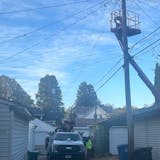•••
I am writing on behalf of the American Clean Power Association (ACP) regarding the recent article about the wind turbine blade disposal issue in Grand Meadow, Minn. The situation highlights an opportunity the renewable energy industry is working diligently to resolve (“Passing the buck on giant trash,” Aug. 11).
Roughly 80 to 94% of a wind turbine (by mass) is made up of readily recyclable materials, including steel, copper, aluminum and iron. The blades, made of durable fiberglass and carbon fiber, present unique disposal challenges. A variety of techniques exist for blade recycling and repurposing, but transportation costs significantly impact the feasibility of any disposal solution. Further, blade disposal and recycling infrastructure is currently limited in the number of blades that can be processed annually; expanding this infrastructure could make recycling more achievable at the volume the industry needs, as some blades today may need to travel over 1,600 miles to reach their destination.
Wind manufacturers are also developing new technologies for blade materials that will enhance recycling opportunities as well as supporting more durable, cost-effective and longer wind turbine blades, boosting energy capture and reliability.
Alongside the crucial transition to renewable energy comes the responsibility to manage infrastructure life cycles. As champions of wind energy, we understand the frustration of the Grand Meadow community as recycling and reuse options continue to ramp up to accept the volume of available blades and to bring costs down. On a broader scale, the industry is investing in research and development to create more efficient and accessible recycling methods, but these efforts take time. As the renewable energy sector matures, so will the solutions to these challenges.
To learn more about blade disposal options, see an ACP paper at tinyurl.com/decommissioned-blades.
Tom Vinson, Washington, D.C.


